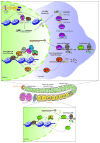Homeland security in the C. elegans germ line: insights into the biogenesis and function of piRNAs
- PMID: 24149573
- PMCID: PMC3928187
- DOI: 10.4161/epi.26647
Homeland security in the C. elegans germ line: insights into the biogenesis and function of piRNAs
Abstract
While most eukaryotic genomes contain transposable elements that can provide select evolutionary advantages to a given organism, failure to tightly control the mobility of such transposable elements can result in compromised genomic integrity of both parental and subsequent generations. Together with the Piwi subfamily of Argonaute proteins, small, non-coding Piwi-interacting RNAs (piRNAs) primarily function in the germ line to defend the genome against the potentially deleterious effects that can be caused by transposition. Here, we describe recent discoveries concerning the biogenesis and function of piRNAs in the nematode Caenorhabditis elegans, illuminating how the faithful production of these mature species can impart a robust defense mechanism for the germ line to counteract problems caused by foreign genetic elements across successive generations by contributing to the epigenetic memory of non-self vs. self.
Keywords: 22G-RNA; Argonaute proteins; C. elegans; Piwi/PRG-1; biogenesis; epigenetics; germ line; piRNA/21U-RNA; transgenerational silencing.
Figures

Similar articles
-
C. elegans piRNAs mediate the genome-wide surveillance of germline transcripts.Cell. 2012 Jul 6;150(1):78-87. doi: 10.1016/j.cell.2012.06.016. Epub 2012 Jun 25. Cell. 2012. PMID: 22738724 Free PMC article.
-
Maternal piRNAs Are Essential for Germline Development following De Novo Establishment of Endo-siRNAs in Caenorhabditis elegans.Dev Cell. 2015 Aug 24;34(4):448-56. doi: 10.1016/j.devcel.2015.07.010. Epub 2015 Aug 13. Dev Cell. 2015. PMID: 26279485
-
Emerging roles and functional mechanisms of PIWI-interacting RNAs.Nat Rev Mol Cell Biol. 2023 Feb;24(2):123-141. doi: 10.1038/s41580-022-00528-0. Epub 2022 Sep 14. Nat Rev Mol Cell Biol. 2023. PMID: 36104626 Review.
-
Piwi and piRNAs act upstream of an endogenous siRNA pathway to suppress Tc3 transposon mobility in the Caenorhabditis elegans germline.Mol Cell. 2008 Jul 11;31(1):79-90. doi: 10.1016/j.molcel.2008.06.003. Epub 2008 Jun 19. Mol Cell. 2008. PMID: 18571451 Free PMC article.
-
piRNA clusters as a main source of small RNAs in the animal germline.Biochemistry (Mosc). 2013 Jun;78(6):572-84. doi: 10.1134/S0006297913060035. Biochemistry (Mosc). 2013. PMID: 23980884 Review.
Cited by
-
Small RNA pathways in the nematode Ascaris in the absence of piRNAs.Nat Commun. 2022 Feb 11;13(1):837. doi: 10.1038/s41467-022-28482-7. Nat Commun. 2022. PMID: 35149688 Free PMC article.
-
Rapid evolution and conserved function of the piRNA pathway.Open Biol. 2019 Jan 31;9(1):180181. doi: 10.1098/rsob.180181. Open Biol. 2019. PMID: 30958115 Free PMC article. Review.
-
CSR-1 and P granules suppress sperm-specific transcription in the C. elegans germline.Development. 2015 May 15;142(10):1745-55. doi: 10.1242/dev.121434. Development. 2015. PMID: 25968310 Free PMC article.
-
Elements and machinery of non-coding RNAs: toward their taxonomy.EMBO Rep. 2014 May;15(5):489-507. doi: 10.1002/embr.201338390. Epub 2014 Apr 14. EMBO Rep. 2014. PMID: 24731943 Free PMC article. Review.
-
Endogenous siRNAs: regulators of internal affairs.Biochem Soc Trans. 2014 Aug;42(4):1174-9. doi: 10.1042/BST20140068. Biochem Soc Trans. 2014. PMID: 25110021 Free PMC article. Review.
References
-
- Lin H, Spradling AC. A novel group of pumilio mutations affects the asymmetric division of germline stem cells in the Drosophila ovary. Development. 1997;124:2463–76. - PubMed
-
- Aravin A, Gaidatzis D, Pfeffer S, Lagos-Quintana M, Landgraf P, Iovino N, Morris P, Brownstein MJ, Kuramochi-Miyagawa S, Nakano T, et al. A novel class of small RNAs bind to MILI protein in mouse testes. Nature. 2006;442:203–7. - PubMed
-
- Girard A, Sachidanandam R, Hannon GJ, Carmell MA. A germline-specific class of small RNAs binds mammalian Piwi proteins. Nature. 2006;442:199–202. - PubMed
Publication types
MeSH terms
Substances
Grants and funding
LinkOut - more resources
Full Text Sources
Other Literature Sources
